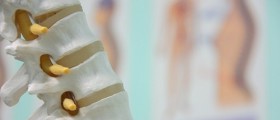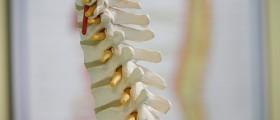
Spinal discs
The spine is a unique bony structure that serves as the root of the entire skeletal system. The arms, legs, rib cage and the head are all attached to it. The spine is also very flexible, which enables our bodies to perform a large number of motions. This is due to its structure. It is composed of a number of vertebrae, cylindric bones that are stacked on top of one another.
Like all other bones, they are joined together by joints. What allows for the degree of freedom in joints between vertebrae necessary for the complex motion of the spine is the appearance of these joints. Vertebrae are slightly concave (sunk) and the area between two vertebrae is filled by what is known as a disc. It is a convex lens-like structure that both serves as dampener and allows for Flexing of the joint in any direction, full circle. This disc consists of a hard and elastic outer layer filled with dense liquid substance, similar to jelly. Eventually, these discs can cause some trouble.
Herniated discs
Like all structures of the body, spinal discs suffer from wear and tear, can be damaged by disease or degenerative process, or can simply be pushed too hard. In some cases, this can cause the outer layer of the disc to rupture, and the jelly – like substance from its interior to 'leak' out, or the exterior layer weakens and the jelly bulges out.
This is known as a spinal disc hernia. Herniation can happen to any disc, between any two vertebrae, but it is most common in the neck and in the lower part of the back. Neck is prone to hernias as it is frequently, virtually constantly used, has a large degree of motion and is burdened by the mass of the head. In other words, spinal discs in the neck are more often than not exposed to stress and are very likely to become herniated.
Symptoms of herniated spinal disc in the neck
Typical symptoms of the herniated disc in the neck are either neck pain or numbness in the neck. This is caused by pressure that the leaked or bulging jelly exerts on the nearby nerve. The nerve interprets this like pain in the region that it innervates (nerves themselves do not 'feel' pain), and this is registered as pain in the muscles between the neck and the shoulder. This pain can also be felt down the arm. Other symptoms include a sensation of weakness in the neck, shoulders, chest, arms, and hands, or a tingling sensation or numbness in one arm, on the side where the hernia is. Weakness in both arms or legs is a serious problem as it indicates that the spinal cord itself is affected. This is a medical emergency and requires immediate medical health. Other symptoms that indicate that the injury is serious include loss of bladder or bowel control and burning pain in the shoulders, neck and the arm.
Diagnosis and treatment
Diagnosis is done through revising of the medical history and tests such as X-ray, MRI and CT, as well as measuring of nerve impulses by electromyography.
If possible, treatment is conservative and includes rest, modified activities and specific exercises, followed by drug therapy with muscle relaxers, analgesics, and anti-inflammatory medicines and other procedures, depending on the recommendation of your doctor. Surgery can be an option if there is no improvement from conservative therapy.






-Causes,-Symptoms,-Diagnosis,-Treatment_f_280x120.jpg)










Your thoughts on this
Loading...